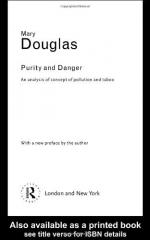
|
| Name: _________________________ | Period: ___________________ |
This test consists of 15 multiple choice questions and 5 short answer questions.
Multiple Choice Questions
1. What does Douglas believe unsuccessful structures invite?
(a) Danger.
(b) Witches.
(c) Rivalry.
(d) Pollution.
2. How do the Lele distinguish between pollution and purity?
(a) Classifying animals.
(b) Washing hands before preparing food.
(c) Using certain hands for certain actions.
(d) Using fire in sacrifices.
3. As excrements pass the boundary of the body, what do they present to the cultures Douglas describes?
(a) Pollution.
(b) Danger.
(c) Sacrifice.
(d) Purity.
4. What is considered to be destructive of rituals in Chapter 9?
(a) Sexuality.
(b) Purity.
(c) Quarreling.
(d) Adultery.
5. What do the Bemba believe can transfer through fire?
(a) Adultery.
(b) Murder.
(c) Premarital sex.
(d) Incest.
6. What are kept and preserved to prevent from endangering others in the cultures Douglas describes?
(a) Social barriers.
(b) Moral offenses.
(c) Sex pollution.
(d) Areas of margin.
7. What does the allegiance established through marriage determine in Purity and Danger?
(a) Sexual collaboration.
(b) Political structure.
(c) Sacrifices necesary to reclaim purity.
(d) Purification.
8. If a husband's life is threatened, who is to blame in Nuer beliefs?
(a) His father.
(b) His mother.
(c) His children.
(d) His lover.
9. What do external boundaries involve, according to Douglas?
(a) Social order.
(b) Purity.
(c) Communcal sacrifice.
(d) Perosnal inclinations.
10. What does the reading state success-based beliefs represent?
(a) Distribution of purity and pollution.
(b) Distribution of wealth.
(c) Distribution of positive power.
(d) Distribution of status.
11. In the Hebrew religion, what could only be touched through sacrifice?
(a) Blood.
(b) Water.
(c) Beef.
(d) Pork.
12. What do primitive cultures and Christianity have in common in Douglas' opinion?
(a) Virginity.
(b) Sexuality.
(c) Pollution.
(d) Virility.
13. In what society described are elders with powers able to control juniors but not for personal gain?
(a) Lugbara.
(b) Central Africa.
(c) Maoris.
(d) Witchcraft covens.
14. What example is given to describe why a sorcerer would move animals to the human sphere?
(a) To anger God.
(b) To sacrifice the animal's blood.
(c) To exploit them for evil powers.
(d) To consume them in hard times.
15. How can adulterers become free from guilt, as described in Nuer society?
(a) By performing a sacrifice.
(b) By getting a divorce.
(c) By cleansing themselves of pollution.
(d) By praying.
Short Answer Questions
1. If a woman is endangered in child labor, who is condemned in Nuer culture?
2. What does Douglas claim is assured through collaboration?
3. What pollution does the Bushong king practice as a part of sacrifice?
4. What does Douglas describe boundaries as altering?
5. What do moral offenses truly depend on, according to Douglas?
|
This section contains 412 words (approx. 2 pages at 300 words per page) |

|




